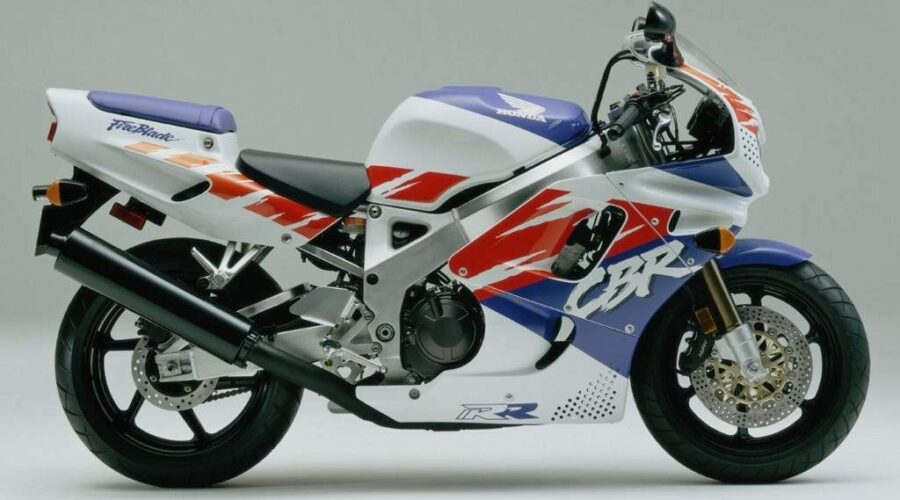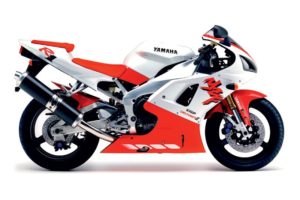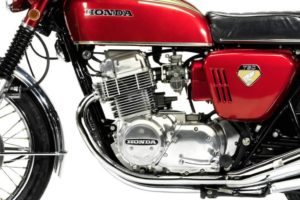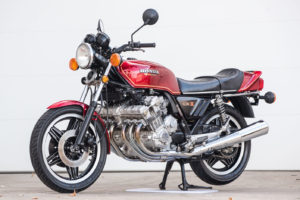1992 and 1994 Honda CBR900RR Fireblade
According to a person who knows a lot about these things — Guido from AllMoto — we have Honda to thank for “presenting us with the prototype of the modern liquid-cooled litre-class weapon.” The bike in question is the 1992 Honda CBR900RR Fireblade, which offered the performance of its 1000cc-1100cc rivals in a package that weighed just 185kg and had the agility and responsiveness of a 600. The first update in 1994 was an even sharper, more track-focussed machine. Two Wheels’ gun roadtester at the time, Mick Matheson, summed it up nicely. “The Fireblade experience is awesome in its completeness,” he wrote. Here are his original Two Wheels roadtests, including track time on the 1992 model at Phillip Island and the 1994 update at Eastern Creek, plus Guido’s assessment of the early Blades as potential collectables.

1992: Flames of Passion
The pit marshal waves me through with a grin. The pit exit marshal gives me a business-like thumbs-up. The CBR900RR gets the front end up and up. I’ve never been a wheelie man but the Honda is an undeniable wheelie bike.
On to the straight. Second, third, fourth and there’s Turn One looming large and coming at over 240km/h. Hook in. Low. Fast. On the gas again, then down to third through Southern Loop, holding wide. Apex late, where the camber’s bad and the track is downhill. On the power…
Up a gear and fly into the left kink. Power again, teasing the nerve as Honda hairpin fills the scene. Two big front discs wash off speed. Foot taps down to first and we pitch in, grinding the right footpeg.
The rear tyre skips on a fat scar but bites hard as the revs soar on the exit. Second gear, touch of brakes, crank into Siberia’s left hander. Peg and knee slider suffer, but the front tyre doesn’t as it rises on the power.
Accelerate through the high speed left and right Hayshed (the bumpy line doesn’t faze the bike) before a dab of brakes and the wide line into Lukey Heights. Apex at the crest, scoot over and down into MG, hard on the brakes and down to first (sometimes neutral, the gearbox’s only faux pas.)
More scraping. Into the following left, we haul the bike up and over the wide tyres, shove it down on the left and flick up a gear. Gas it through, up the gears and hold it wide into the last corner. Faster, faster. Wide … wide. Finally, brush in on the late apex and drift out onto the straight. Redline, redline.
If the approach was good, the straight yields a speed nudging 260 km/h before a flick down a gear shoots us into Turn One again.
A few minutes later I’m back in the pits. What a buzz! There’s the inevitable motorcyclist’s grinning and gesticulating after a good ride. But hang on …
What was the bike like? The first session was re-learning the track after an 18-month absence. Second time around was to learn the bike. I hadn’t noticed it that second time out.
Honda has promised to “provide maximum enjoyment through total control” with the CBR900RR. If total control means effortlessness to the point of not even noticing the bike, then it scores top marks. Simple as that.

Or is it? The RR’s total control happens by way of a brilliant blend and balance of chassis, suspension, geometry, engine and ergonomics. Any remaining doubt comes from one crucial fact: Phillip Island is a rider’s circuit, which can disguise one or two potential shortcomings of a rider’s bike. An international release at Phillip Island — one of the world’s best racetracks — of Honda’s sporting-market re-entry bike is a far cry from a road test, especially when there’s no control bike to compare it with, such as a Yamaha FZR1000 or Ducati 851.
Phillip Island held little prospect for testing the one area of the CBR’s design which caused most speculation: stability over rough roads. The circuit simply doesn’t have any bumps to speak of which could come near to public road conditions. Honda had the test bikes’ suspension set firm for the track and I had to aim for the mildly bumpy lines to stop the machine from completely smoothing out the ride. The closest I got to any instability were small twitches as the front end got light with the throttle open. In all other ways, the RR was impeccable in its chassis stiffness and suspension capability.
The road plays host to bigger bumps, though, so judgement is reserved until then. I suspect a steering damper may prove a worthwhile addition.

The front end may be light, but it stays riveted to smooth tar for the rest of the ride. Southern Loop’s late apex is invisible until you’re nearly into it. It’s hidden in a downhill run and angles off camber — nightmare material at speed. Even a Guzzi 1000S, my only other ride around this circuit, felt slightly strained.
The RR didn’t. Off the gas, on the power or trailing the throttle — even pulling down a tighter line — the Honda swept through. No nervous strain through the ‘bars nor squirming from the front Bridgestone radial. And with the peg gently caressing the tar it was reassuring to know the front tyre had its safety zone of untouchable tread.
Both tyres are superb. At full lean, rolling the throttle, I got one noticeable slide from the rear, which by then was very worn. It was the most gentle, gradual and controllable slip I’ve ever experienced. And only later did I remember I’d had half a dozen others, so mild that they barely registered in the grey matter, let alone activated the adrenal glands.
When the pegs touched down on only my second track session I wondered why Honda had made the mistake of such limited cornering clearance. But it hadn’t. Clearance is excellent and the folding footpegs are merely a message that the rear tyre is approaching its generous limits, although you can still tip further. Racers may not appreciate this input but it’s a welcome warning on the road. The fact that it’s so easy to bank so far so effortlessly and securely on the RR is a credit to the Honda’s (and Phillip Island’s) rideability.

Such riding ecstasy owes a lot to the RR’s sweet steering — neutral, responsive and deadly accurate. I’ve mentioned the subtle ease of line changing and confident grip. Add to this every high praise, bar the usual fat-tyred limits: standing up under brakes; tipping in when they’re released in a corner; and some effort in flicking from full lean one way to the other. The last of these could be beaten with body weight. Slinging from right to left after MG corner took a haul of the ‘bars to bring it up and a push down to bury it into the left-hander but there was no complaining wiggle or slide from the bike. Naturally high-speed steering takes some muscle, too.
Body english is bliss on the CBR900. Climbing aboard for the first time, you’re surprised at the apparent bulk of the fat tank and wide seat. But ‘bars, pegs and controls fall naturally to hands and feet and, once mobile, the initial surprise is forgotten. You can ride bolt upright (it’s too little to judge by, but a couple of cruising laps left a suspicion that licence preservation shouldn’t be too painful), or you can go for it GP style: hanging off for hairpins; half-hanging while tucking down flat out through a sweeper; shifting forward to weight the front end out of corners; or crouching in the fairing’s spartan sports protection on the straight — all with no aches or pains after a long, hard day, which is more than I can say for many other sports bikes.
Southern Loop leads temptingly into a kinked straight and, on the RR, about 240 km/h before Honda hairpin. I’m a confirmed road rider when it comes to braking, even on a track. But twice I got the back end reaching for the sky into the hairpin without having to look for the emergency exit road … except once.

I made a crucial error as I flashed past the “150 metres to go” marker: I looked at the speedo. I saw more than 200 km/h. Puckered panic welled up but thought took control again — reassuring thought. I’d done this the same every time so far so why crash now? I didn’t, and even with a pause for fright the RR’s brakes mashed the speed.
At those high paces the Honda’s brakes don’t bite hard but still scrub off speed with mocking ease, boasting excellent feedback and stability. The rear disc can be left to its proper use — added stability at low speed.
Finishing off the package is a seemingly nondescript powerplant. Peak power and torque figures won’t set the world alight but the delivery of those numbers inspires. Honda wanted a smooth delivery from bottom to top end and that’s what the RR’s got. I didn’t notice any significant vibration, either.
Cruising the circuit in top gear saw revs drop to as low as 2000 through Honda corner but the CBR is blessed with a linear power delivery which starts somewhere down in those lower depths of engine speed and pulls the lightweight machine smoothly and strongly all the way through to redline. There’s no obvious peak or trough; flexibility is the name of the game and the 900 gave a choice of two gears through most corners.

In top-end terms, the CBR sits where its 900cc should — somewhere between the 750s and 1000/1100s — but through the bottom end and mid-range it’s hard to separate from the litre-plus bikes.
No doubt the lighter weight helps the motor push harder, too. The RR has an inspiring power-to-weight ratio, each kilowatt pushing barely more than two kilograms (on a par with the FZR1000, but more usable, thanks to the much lower overall weight).
That’s the CBR900RR’s real success — litre-bike performance with 600-class weight. As far as this track test session is concerned, everything built around the weight-saving scheme has come together in a unique and proficient way.
The question of stability on bumps remains unanswered. It depends upon whether the front tyre truly acts like the 17-incher its outside diameter mimics and how well the front suspension and geometry has been sorted.
The other question is price. Honda Australia, relying on the ailing Oz dollar, is aiming for GSX-R1100/FZR1000 money. It will poach buyers from the litre-bike competition unless it’s purely power that’s important. But at the relatively high price of the class, will the 900 win the converts it deserves from the ever-popular 750 class?
We’ll know in a few weeks’ time when the Honda is released. It’s the first serious sports bike Honda has offered en-masse in a long, long time. The company has done it in convincing fashion, for the CBR900RR could prove better than the FZRs, GSX-R11s and 750s, ZXRs and 851s — all of them very different from each other — in almost all respects.
By Mick Matheson. Two Wheels, April 1992.

1994: Flying Blade
As good as the Suzuki and Kawasaki 900s are, it’s the Fireblade which does it for me. I’ll crack open the throttle of a ZX-9R any day, just to feel that incredible kick in the arse it gives as the induction moan turns to a mighty roar. Nothing could stop me from thrilling to the fast-cruising grace of the sleek RF900R. But put the Honda between my legs and I’ll be reduced to a slavering basket case in expectation of the purity of its cornering, its urgent rush into, through and out of bends.
Ahead of the Fireblade and I lay the promise of four – Four! — race track sessions, one for the photos, one for a race course with Stay Upright, and two ride days courtesy of Stay Upright and Filco Oils. Three at Eastern Creek, one at Amaroo. No kid with a pocketful of money in a sweet shop, no junkie in the Golden Triangle, no sex addict at an ecstasy party could have felt the anticipation and wanting that I did.
To make matters worse the CBR was a tiger — the brown, yellow and steely beige rocket which is available in greater numbers this year than the race-look red-white-blue model but still gets called a Limited Edition. It looks hot and the new headlights only emphasise the latent aggression of the Honda. Either that or you just see Dame Edna in a tiger skin coat…
If you line up the new Fireblade with an older one you’ll see a host of little details changes — at least 27 of them, from the finish on the muffler to the fuel tap, from the number of holes in the upper fairing to the new holes drilled in the footrest guards. The cylinder head cover is now magnesium to save about 300 grams, one of several weight-saving measures which are offset by more strength in other areas. Overall, claimed weight is unchanged.
That’s a good thing because it’d be heartbreaking to see Honda’s sporting weapon gain weight like so many great sportsbikes over the years. The 185 dry kilograms in this motorcycle are almost perfectly spread between the wheels for that all-important balance. It has the feel of a 600 backed by more power than any 750 has yet dared contemplate.

Throw a leg over the ‘Blade and it still feels more than a 600, thanks to the fat tank which spreads your legs wide. Strange at first but easy to get used to. There’s the hard, flat seat, not-quite-too-high footpegs and low handlebars just forward of your knees. The screen sits 15 mm higher and 20 mm closer than before, but you don’t notice this until you get moving.
A few seconds of choke at a perfect 2000 rpm warms the beast before you ease out the clutch and move off. At first the ‘Blade is awkward, needing precise steering inputs to roll it around that fat front tyre. At city speeds it tends to pitch and roll on the uneven surfaces, a legacy of the taut suspension and radical steering geometry. But the light controls, fierce but controllable brakes and low-down power endow the 900 with charming town manners. Which means you get to the good roads in better shape…

My first fang on the CBR was at Eastern Creek one cool but fine morning. The track is the ultimate place to experience a machine like this, with no limits but your own.
Here the 1994 900RR is a little better than before, too, with its revised front and rear suspension giving it a stiffer, more responsive ride which puts you in even better touch with what’s happening where rubber meets tarmac. A stiffer spring and the addition of compression damping adjustment up front gives the forks the extra finesse they lacked before. The rear shock has altered damping rates.

Trouble is, get out on the road and the harder suspension is not as good as before. It’s almost as if Honda has taken the hardest rates of last year and made them the minimum for this year. Normally I like my bikes set up firmly but this one was the first I’ve had to back off so much. For the road I had the rear rebound and compression wound right off and the front softened almost as much.
Even so the CBR900RR ricocheted off bumps at high speed as if the damping’s compression rates were not letting the springs compress. It can be a bone-jarring, ball-crushing ride which has you wondering whether the next big bump will bounce you off line or beyond the ability of recovery of the tyres. The bike wriggles and squirms between bounces but I never had the shock of tankslapping; others mentioned one or two cases though.
The CBR is now definitely overdamped. I believe the previous models handled the rough better, even if they did tankslap more readily. However, only the rough will slow down the ’94 model. Back on the track, or on a smooth road, nothing seems to faze it.
A change to RC30 style footpegs has the long extensions scraping easier than last year but the Honda is capable of confidently taking you through Turn One at the Creek with sparks flying off the ‘pegs. When even a ham-fisted journo like me (with some help from Stay Upright) can get around Amaroo on his second visit there in 57 seconds on a dead stock motorcycle, you know the bike’s got to be good.
Squeeze the front brake lever and there’s instant bite followed by plenty of stopping power. Just make sure the lever’s adjusted out as far as possible to allow for the excessive travel before the brakes actually start to work.

Sometimes, when I wasn’t giving it quite enough attention, the gearbox would punish slackness by not slotting down a gear, particularly third to second, and I wouldn’t always realise this in time to comfortably tap the pedal again. The Honda will crank hard into a corner while still on the brakes and there always seems to be a little more braking to be had if you need it. By the time you’re into the corner and ready to get on the gas, the light throttle and progressive brakes make for a gentle transition from one to the other.
Through the apex the Battlax tyres flatten off at their edges for a huge contact patch and all the confidence which goes with it. Footpegs will take a hammering on the track and aren’t beyond the limit on the road but get serious and you’ll have the pipe scraping in right-handers — although I never took it that far. The Fireblade’s balance is so perfect you will know exactly when the pegs are about to scrape.
And you’ll know just when you can get on the gas too. There may be stickier tyres than the road-compound Battlaxes which come fitted but these are still excellent. The Fireblade will lay long black lines from its back tyre with ease. The tyre will take a handful of horsepower even while on its edge, spinning but not necessarily sliding out at all.
When the bike comes more upright and the throttle gets twisted harder the front end levitates. Speed rises obscenely as you flick up the more positive, quicker shifting six-speeder and seek out the next corner or follow all the gears in the rush past 200 km/h, on to 240 and somewhere beyond 260 km/h if the road is long enough and your patience up to it. About 240 before braking on the Eastern Creek straight is only just shy of the FZR1000’s speed.
The Fireblade experience is awesome in its completeness. Honda has taken this past just the incredible ride, too, by throwing in the storage space under the flip-up pillion perch, fold-out tiedown hooks under the same seat and a few other niceties besides. It is also one of the few four-cylinder motorcycles you can sit down by and admire, detail by detail. Its spartan construction leaves lots of open space. You can see in, around and even through so much of the bike.

There is little to complain about. Fuel consumption, switches, dash layout and the rest all rate well. Surprisingly the CBR is easy to ride two-up if you’re not pushing too hard; the grunty engine and slick gear changes smooth the ride nicely for pillions, who have nothing but you or the tank for support. The hard seat and low handlebars cause some aches but the 900 is reasonably tourable.
It’s satisfying to know the bike you have can do all this but it wouldn’t matter if the CBR900RR was only half as civilised — as long as it still gave the same thrills and excitement on a winding road. As it is the over-damped suspension is an inadequacy which restricts roadgoing pleasure and confidence at times. Yet the 900 is such a fine blend of power and weight that it remains in my mind the best sportsbike you can get for less than 20 grand. Nothing else has the rounded performance of the Fireblade — the agility, power delivery, responsiveness and feel. The balance.
Spend more than a little time together with the Fireblade and you’ll find it’s wired directly to your brain and your soul. It just feels soooo good.
By Mick Matheson. Two Wheels, October 1994.

Guido from AllMoto discusses the collectable potential of the early Blades, with background from the project’s Chief Engineer Tadao Baba, and a cool vid where he looks at the significance of the Honda in the sports bike pantheon, assesses its ability and the ownership experience, based on living with his own original 1992 model here.




